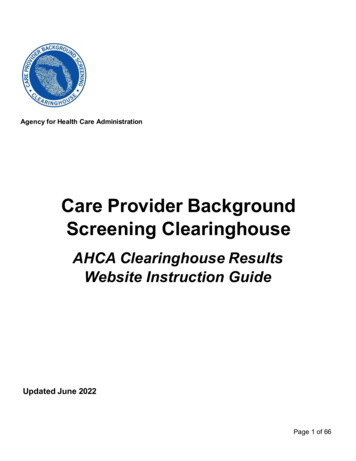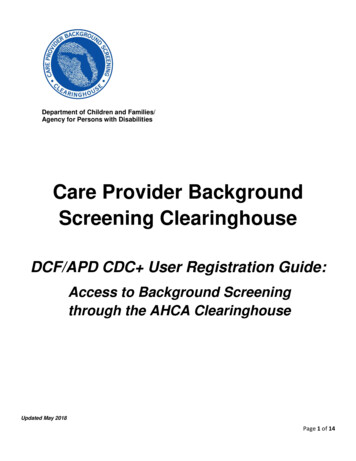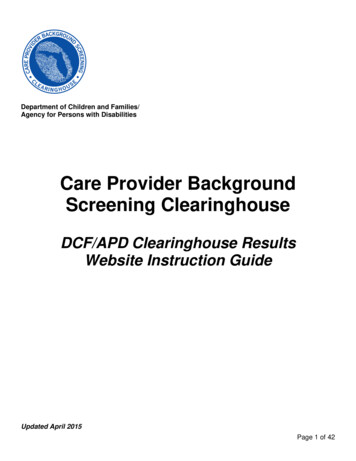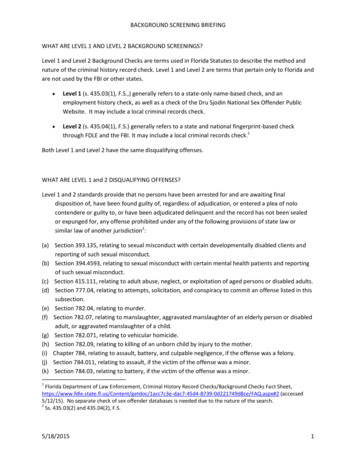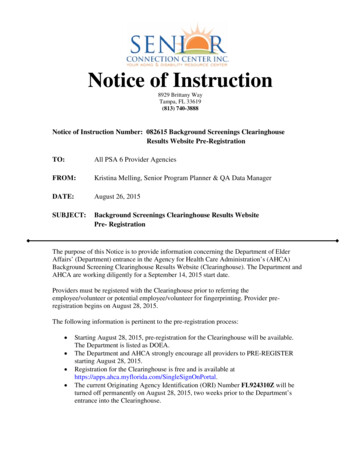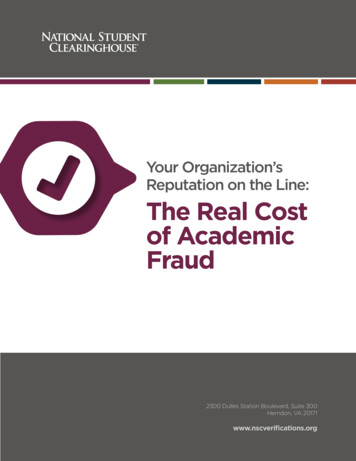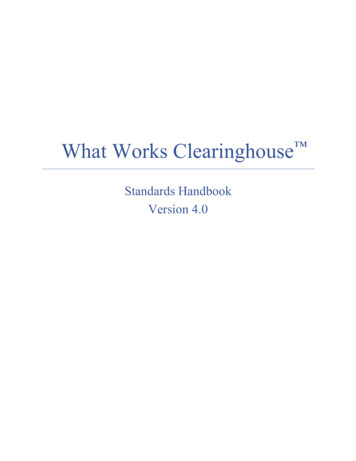
Transcription
What Works Clearinghouse Standards HandbookVersion 4.0
What Works ClearinghouseStandards Handbook, Version 4.0CONTENTSIINTRODUCTION .1IIRANDOMIZED CONTROLLED TRIALS AND QUASI-EXPERIMENTALDESIGNS .5A. Individual-Level Assignment.5B. Cluster-Level Assignment .19C. Other Analytic Approaches.311. Propensity Score Analyses .312. Analyses in Which Subjects Are Observed in Multiple Time Periods .323. Analyses with Potentially Endogenous Covariates.354. Analyses with Missing Data .36D. Complier Average Causal Effects .47III1. Criteria for Whether RCT Studies are Eligible for Review Under CACEStandards .482. Overview of Process for Rating CACE Estimates .503. Calculating Attrition when Rating CACE Estimates .514. Procedures for Rating CACE Estimates when Attrition is Low .545. Procedures for Rating CACE Estimates when Attrition is High .56REGRESSION DISCONTINUITY DESIGNS .58A. Assessing Whether a Study is Eligible for Review as an RDD .58B. Possible Ratings for Studies Using RDDs .60C. Standards for a Single RDD Impact.60D. Applying Standards to Studies that Report Multiple Impact Estimates .72E. Applying Standards to Studies That Involve Aggregate or Pooled Impacts .72F. Cluster-Assignment Regression Discontinuity Designs .73G. Reporting Requirement for Studies with Clustered Sample .77H. Reporting Requirement for Dichotomous Outcomes .77IVNON-DESIGN COMPONENTS .78A. Outcome Requirements and Reporting .78B. Confounding Factors .80REFERENCES .84APPENDIX A: PILOT SINGLE-CASE DESIGN STANDARDS . A-1ii
What Works ClearinghouseStandards Handbook, Version 4.0APPENDIX B: ASSESSING BIAS FROM IMPUTED OUTCOME DATA.B-1APPENDIX C: BOUNDING THE BASELINE DIFFERENCE WHEN THERE AREMISSING OR IMPUTED BASELINE DATA .C-1APPENDIX D: ADDITIONAL DETAIL FOR REVIEWS OF STUDIES THATPRESENT CACE ESTIMATES . D-1iii
What Works ClearinghouseStandards Handbook, Version 4.0TABLESII.1.Highest Differential Attrition Rate for a Sample to Maintain Low Attrition, byOverall Attrition Rate, Under “Optimistic” and “Cautious” Assumptions.13II.2.Absolute Effect Size (ES) at Baseline .14II.3.Examples of AccepApproaches for Satisfying the WWC Statistical AdjustmentRequirement .16II.4.Three Categories of Joiner Risk Specified in Review Protocols .25II.5.Allowable Reference Samples for Calculating Individual Non-Response .26II.6.AccepApproaches for Addressing Missing Baseline or Outcome Data .39II.7.First-Stage F-Statistic Thresholds for Satisfying the Criterion of SufficientInstrument Strength .55III.1.RDD Study Ratings.60III.2.Satisfying the Integrity of the Forcing Variable Standard (Standard 1) .62III.3.Satisfying the Attrition Standard (Standard 2).63III.4.Satisfying the Continuity of the Relationship Between the Outcome and theForcing Variable Standard (Standard 3) .66III.5.Satisfying the Functional Form and Bandwidth Standard (Standard 4) .68III.6.Satisfying the FRDD Standard (Standard 5) .71iv
What Works ClearinghouseStandards Handbook, Version 4.0FIGURESI.1.Steps of the WWC Systematic Review Process and the WWC Handbooks .2II.1.Study Ratings for Individual-Level RCTs and QEDs.6II.2.Attrition and Potential Bias .11II.4.Review Process for Cluster-Level Assignment Studies.22II.5.Study Ratings for RCTs and QEDs with Missing Outcome or Baseline Data .37II.6.Review Process for Studies that Report a CACE Estimate .51A.1.Study Rating Determinants for SCDs . A-4A.2.Depiction of an ABAB Design . A-9A.3.An Example of Assessing Level with Four Phases of an ABAB Design . A-10A.4.An Example of Assessing Trend in Each Phase of an ABAB Design. A-10A.5.Assess Variability Within Each Phase . A-10A.6.Consider Overlap Between Phases . A-11A.7.Examine the Immediacy of Effect with Each Phase Transition . A-11A.8.Examine Consistency Across Similar Phases . A-12A.9A. Examine Observed and Projected Comparison Baseline 1 to Intervention 1 . A-12A.9B. Examine Observed and Projected Comparison Intervention 1 to Baseline 2 . A-13A.9C. Examine Observed and Projected Comparison Baseline 2 to Intervention 2 . A-13v
What Works ClearinghouseStandards Handbook, Version 4.0I. INTRODUCTIONIt is critical that education decision makers have access to the best evidence about theeffectiveness of education products, programs, policies, and practices. However, it can bedifficult, time-consuming, and costly for decision makers to access and draw conclusions fromrelevant studies about the effectiveness of these interventions. The What Works Clearinghouse(WWC) addresses the need for credible, succinct information by identifying existing research oneducation interventions, assessing the quality of this research, and summarizing anddisseminating the evidence from studies that meet WWC standards.The WWC is an initiative of the U.S. Department of Education’s Institute of EducationSciences (IES), which was established under the Education Sciences Reform Act of 2002. It is animportant part of IES’s strategy to use rigorous and relevant research, evaluation, and statistics toimprove our nation’s education system. The mission of the WWC is to be a central and trustedsource of scientific evidence for what works in education. The WWC examines research aboutinterventions that focus on improving educationally relevant outcomes, including those forstudents and educators.The WWC systematic review process is the basis of many of its products, enabling theWWC to use consistent, objective, and transparent standards and procedures in its reviews, whilealso ensuring comprehensive coverage of the relevant literature. The WWC systematic reviewprocess consists of five steps:1.Developing the review protocol. A formal review protocol is developed for each revieweffort, including one for each WWC topic area (e.g., adolescent literacy, primarymathematics, or charter schools), to define the parameters for the research to be includedwithin the scope of the review (e.g., population characteristics and types of interventions);the literature search (e.g., search terms and databases); and any topic-specific applications ofthe standards (e.g., acceptable thresholds for sample attrition and characteristics for groupequivalence).2.Identifying relevant literature. Studies are gathered through a comprehensive search ofpublished and unpublished publicly available research literature. The search uses electronicdatabases, outreach efforts, and public submissions.3.Screening studies. Manuscripts are initially screened for eligibility to determine whetherthey report on original research, provide potentially credible evidence of an intervention’seffectiveness, and fall within the scope of the review protocol.4.Reviewing studies. Every eligible study is reviewed against WWC standards. The WWCuses a structured review process to assess the causal validity of findings reported ineducation effectiveness research. The WWC standards focus on the causal validity withinthe study sample (internal validity) rather than the extent to which the findings might bereplicated in other settings (external validity).5.Reporting on findings. The details of the review and its findings are summarized on theWWC website, and often in a WWC publication. For many of its products, the WWCcombines findings from individual studies into summary measures of effectiveness,including the magnitude of findings and the extent of evidence.1
What Works ClearinghouseStandards Handbook, Version 4.0In addition, the WWC reviews some studies outside of the systematic review process, suchas those that receive significant media attention. These reviews are also guided by a reviewprotocol, and use the same WWC standards and reporting procedures.This What Works Clearinghouse Standards Handbook (Version 4.0) provides a detaileddescription of the standards used by the WWC to review studies (Step 4 above). Steps 1–3 andStep 5 are described in a separate What Works Clearinghouse Procedures Handbook. Takentogether, these two documents replace the single document used since March 2014, the WhatWorks Clearinghouse Procedures and Standards Handbook (Version 3.0). Figure I.1 shows howthe steps of the WWC systematic review process are divided between the two Handbooks.Figure I.1. Steps of the WWC Systematic Review Process and the WWC HandbooksThis Standards Handbook provides a detailed description of the standards used by the WWCwhen reviewing studies that have met eligibility screens, including using one of the followingeligible designs: randomized controlled trial, quasi-experimental design, regression discontinuitydesign, and single-case design. Studies that use other designs are not reviewed by the WWC. TheWWC refers to randomized controlled trials and quasi-experimental designs collectively asgroup design studies. Studies reviewed against WWC standards receive one of the followingthree study ratings indicating the credibility of evidence from the study: Meets WWC DesignStandards Without Reservations, Meets WWC Design Standards With Reservations, or Does NotMeet WWC Design Standards.The substantive differences between this version of the standards (4.0) and the previousversion (3.0) include the following: The regression discontinuity design standards have been revised. The substantivechanges to the regression discontinuity standards are a new set of procedures forreviewing “fuzzy” regression discontinuity designs (for example, those in which someintervention group members do not receive intervention services and the analysis adjustsfor this nonparticipation), expanded procedures for reviewing multi-site and multipleassignment variable regression discontinuity designs, and a preference for localbandwidth impact estimation over global impact regression with flexible functionalforms.2
What Works ClearinghouseStandards Handbook, Version 4.0 The standards for cluster-level assignment studies have been revised. There arethree substantive changes to the cluster standards. First, the language that study authorsuse to describe their inferences will have no bearing on the review process, whereas thislanguage previously could affect a study’s rating. The WWC will review for evidence ofan effect on individuals, and if that evidence does not meet standards, the WWC willreview for evidence of an effect on clusters. In addition to any effects of the interventionon individuals, effects on clusters may include effects of the intervention on thecomposition of individuals within clusters. Second, cluster randomized controlled trialswith individuals who entered clusters after random assignment, called joiners, may beeligible for the highest rating. Previously, the presence of any joiners in the analyticsample meant that the study could only be eligible to be rated Meets WWC GroupDesign Standards With Reservations. Third, studies that can satisfy WWC standardsonly for an intervention’s effects on clusters are not eligible for the highest rating, andthe WWC will need to assess whether the individuals represented in the data used toestimate impacts are representative of the population in the clusters. The standards for studies with missing data have been revised. A group design studythat analyzes a sample with missing data for baseline or outcome measures is eligible tomeet WWC group design standards if it uses an acceptable method to address themissing data and limits the potential bias from using imputed data instead of actual data.Additionally, the standards provide new procedures for assessing baseline equivalencein a quasi-experimental design or high-attrition randomized controlled trial with somemissing or imputed baseline data in the analytic sample. Previously, only low-attritionrandomized controlled trials could analyze imputed data and be eligible to meet WWCgroup design standards. The Standards Handbook includes standards for randomized controlled trials thatpresent complier average causal effects. Studies may estimate the complier averagecausal effect to examine the effects of intervention participation rather than interventionassignment. Additional methods of statistical adjustment can be used to satisfy the baselineequivalence requirement. When the outcome and baseline measure are closely relatedand are measured using the same units, the WWC considers difference-in-differencesadjustments, simple gain scores, and fixed effects for individuals as acceptable statisticaladjustments. The Standards Handbook includes additional clarification of existing standards. Theadditional clarification of the standards is intended to support consistency acrossreviews, and includes guidance on applying standards to propensity score analyses andanalyses in which subjects are observed in multiple time periods, and examples ofconfounding factors.The remainder of the document is organized as follows. Chapter II provides standards forrandomized controlled trials and quasi-experimental designs. This chapter also providesadditional standards for randomized controlled trials that present complier average causal effects(with supplemental technical detail in Appendix D). Chapter III provides standards for studiesthat use regression discontinuity designs. Chapter IV provides information on outcome eligibility3
What Works ClearinghouseStandards Handbook, Version 4.0and confounding factors that applies broadly across designs. Pilot standards for studies that usesingle-case designs are presented in Appendix A.As the WWC uses and applies the standards in this Standards Handbook, reviewers mayoccasionally need additional guidance. If necessary, the WWC will produce guidance documentsfor reviewers that provide clarification and interpretation of standards and support consistencyacross reviews. This WWC reviewer guidance will clarify how these standards should beimplemented in situations where the current Standards Handbook is not sufficiently specific toensure consistent reviews.As the WWC continues to refine and develop standards, the Standards Handbook will berevised to reflect these changes. Readers who want to provide feedback on the StandardsHandbook, or the WWC more generally, may contact us at https://ies.ed.gov/ncee/wwc/help.4
What Works ClearinghouseStandards Handbook, Version 4.0II. RANDOMIZED CONTROLLED TRIALS AND QUASI-EXPERIMENTALDESIGNSThis chapter describes the core elements for the review of two major categories of groupdesigns for intervention studies: randomized controlled trials (RCTs) and quasi-experimentaldesigns (QEDs). While RCTs rely on random assignment to form intervention and comparisongroups, QEDs form these groups using methods other than random assignment. Standards arepresented separately for studies that assign individuals (such as students) to a condition andstudies that assign clusters (such as classrooms or schools) to a condition. The chapter concludeswith specific guidance for reviews of studies that use a variety of common analytical approaches.Although regression discontinuity designs (RDDs) are sometimes considered a type of groupdesign, the WWC applies separate standards to review eligible RDDs. If a cutoff value on aknown measure is used to assign subjects to the intervention and comparison groups, then thestudy may be eligible to be reviewed as an RDD. The WWC eligibility criteria and standards forreviewing RDDs are described in Chapter III.A. Individual-Level AssignmentIn this section, we describe the three steps for reviewing RCTs and QEDs that assignindividual subjects to the intervention or comparison condition:Step 1: Assess the study design,Step 2: Assess sample attrition, andStep 3: Assess equivalence of the intervention and comparison groups at baseline (prior tothe intervention).To be eligible for the WWC’s highest rating for group design studies, Meets WWC GroupDesign Standards Without Reservations, the study must be an RCT with low levels of sampleattrition. A QED or high-attrition RCT is eligible for the rating Meets WWC Group DesignStandards With Reservations if it satisfies the WWC’s baseline equivalence requirement that theanalytic intervention and comparison groups appear similar at baseline. A QED or high-attritionRCT that does not satisfy the baseline equivalence requirement receives the rating Does NotMeet WWC Group Design Standards (Figure II.1). After describing each step in the reviewprocess, we conclude with a set of possible results, pointing readers to the appropriate next stepin the review process.However, individual-level assignment studies that satisfy the requirements outlined in Steps1–3 must also satisfy two additional requirements to be rated Meets WWC Group DesignStandards Without Reservations or Meets WWC Group Design Standards With Reservations.These additional requirements, described in Chapter IV, are that the study must:A. Examine at least one eligible outcome measure that meets review requirements, andB. Be free of confounding factors.Additionally, when studies use certain analytic approaches, including propensity scoreanalyses, analyses in which subjects are observed in multiple time periods, methods to address5
What Works ClearinghouseStandards Handbook, Version 4.0missing data, or include endogenous covariates, additional guidance and standards may apply asdescribed in Section C. In particular, when an analysis uses methods to address missing datasuch as regression imputation, maximum likelihood, or non-response weights, the review processdescribed in the last subsection of Section C (Analyses with Missing Data) should be followedinstead, which includes an assessment of potential bias from using imputed data instead of actualdata. Additionally, standards for reviewing studies that report complier average causal effects aredescribed in Section D.Figure II.1. Study Ratings for Individual-Level RCTs and QEDsNote:To receive a rating of Meets WWC Group Design Standards Without Reservations or Meets WWC Group DesignStandards With Reservations, the study must also satisfy the requirements in Chapter IV, including that the studymust examine at least one eligible outcome measure that meets review requirements and be free of confoundingfactors.Step 1. Study Design: Is intervention and comparison group membership determinedthrough a random process?Randomized controlled trialsThe distinguishing characteristic of an RCT is that study subjects are randomly assigned toone of two groups that are differentiated by whether they receive the intervention. Researchersmay use any of several possible methods to conduct random assignment. For example,acceptable methods of random assignment include blocking the sample into groups beforerandom assignment, using random subsampling, assigning individuals to groups with differentprobabilities, and forming groups of different size.To be valid random assignment, subjects must be assigned entirely by chance and have anonzero probability of being assigned to each group. Subjects do not need to have an equalchance of being assigned to each group, and the chance of being assigned to a particular group6
What Works ClearinghouseStandards Handbook, Version 4.0can differ across subjects. However, if subjects are assigned to a group with differentprobabilities (i.e., if the chance of being assigned to a group differs for subjects within the sameassigned condition), then the findings must be based on an analysis that adjusts for the differentassignment probabilities (see discussion of the second type of compromised RCTs in the nextsubsection). This requirement also applies if the probability of assignment to a group variesacross blocks in a stratified random assignment framework.Compromised RCTsWhen the validity of a random assignment process or the analysis of an otherwise wellexecuted random assignment process is compromised, the study is reviewed using the process forQEDs. There are four ways in which an RCT that assigns individual subjects to the interventionor comparison condition can be compromised. The RCT is compromised when it includes subjects in the sample used to estimatefindings (analytic sample) who were not randomly assigned. The RCT is compromised if subjects are randomly assigned to a group with differentprobabilities, but the findings are based on an analysis that does not account for thedifferent assignment probabilities. Consider a study that conducts random assignmentseparately within two blocks of students. The study includes the same number ofstudents in both blocks, but students in block A are high performing at baseline, whilestudents in block B are low performing at baseline. The study assigns 70 percent ofblock A students to the intervention condition, but assigns only 30 percent of block Bstudents to the intervention condition. In this case, the intervention group includes 70percent high-performing students, while the comparison group includes 70 percent lowperforming students. If the data are analyzed without accounting for the differentassignment probabilities, the dissimilar groups may cause the intervention to appear tohave a positive impact, even if it has none. The three WWC-accepted methods ofaccounting for different assignment probabilities within a group are:o Estimating a regression model in which the covariate set includes dummyvariables that differentiate subsamples with different assignment probabilities,o Estimating impacts separately for subsamples with different assignmentprobabilities and averaging the subsample-specific impacts (weighted orunweighted), ando Using inverse probability weights, formed using the known probabilities ofassignment for each subject, as weights in the analysis.If study authors describe a random assignment process that suggests varyingprobabilities of assignment but do not make one of these adjustments, the RCT iscompromised and the study is reviewed using the process for QEDs. The RCT is compromised when the investigator changes a subject’s group membershipafter random assignment. Consider a study in which some subjects assigned to theintervention condition did not receive the intervention, but remained in the study. Forexample, some students initially assigned to a classroom implementing the interventioncondition may actually attend a different classroom that implemented the comparison7
What Works ClearinghouseStandards Handbook, Version 4.0condition. If the study authors analyze these subjects as members of the comparisongroup, based on not receiving the intervention, random assignment is compromised.However, if the study authors analyze these subjects as members of the interventiongroup, based on their original assignment (an intent-to-treat [ITT] analysis), the integrityof random assignment would be maintained. Put another way, not all subjects mustactually receive their assigned condition, but all subjects must be analyzed according tothe subject’s originally assigned condition. Note that studies that address noncompliance by reporting complier average causal effects (CACE) may be eligible forreview using the standards described in Section D of this chapter. The RCT is compromised when a study author manipulates the analytic sample toexclude certain subjects based on events that occurred after the introduction of theintervention when there is a clear link between group status and the reason for theexclusion. A clear link is present when the exclusion is based on a measure that mayhave been affected by assignment to the intervention or comparison condition. Not allsample exclusions performed by the author will meet this condition, as illustrated in thefollowing examples. Together, these examples illustrate the three ways in which theWWC treats sample exclusions, summarized in Figure II.3: (1) as a compromised RCT,(2) as attrition, or (3) as ignorable (i.e., not counted as attrition and not compromising):o Compromised RCT. If an intervention could affect student attendance (e.g., theintervention could plausibly influence students’ motivation to attend class) andstudy authors exclude from the analysis students with high levels of absenteeism,the RCT is compromised. This outcome is represented by the red box in FigureII.3.o Attrition. Suppose study authors grouped students into pairs and randomlyassigned one student in each pair to the intervention condition. If either student inthe pair was missing outcome data, the exclusion of both students in the pair (orany other larger randomization block) from the analysis would not compromiserandom assignment because there is no clear link between the intervention andattrition of the pair. In this example, the excluded pair counts as attrition, whichdoes not compromise an RCT and is discussed in detail in Step 2 below. Thisoutcome is represented by the yellow box in Figure II.3.o Ignorable (not counted as attrition and not compromising). Some sampleexclusions are considered neither attrition nor compromising. For example, ifstudy authors excluded students at random from follow-up data collection, or leftout of the analytic sample students who shared a certain characteristic measuredprior to the introduction of the intervention (e.g., having individualized educationprograms prior to the study), these exclusions do not compromise randomassignment. Furthermore, the excluded subjects may be removed from theattrition calculation because they were based on a pre-intervention characteristic.This outcome is represented by the green box in Figure II.3, and the distinctionbetween this outcome and exclusions that are counted as attrition is discussedfurther in Step 2 under the subsection on sample loss that is not consideredattrition.8
What Works ClearinghouseStandards Handbook, Version 4.0The WWC considers an RCT to be compromised only when the researcher analyzes datasubject to one of these four concerns. Some valid randomization procedures can produceintervention and comparison groups that appear dissimilar based on chance. The WWC does notconsider these chance differences to compromise the RCT, and such studies are reviewed usingthe usual review process for valid RCTs. Also, if a study reports multiple findings, only some ofwhich the WWC determines to be compromised RCTs, the findings that maintain the integrity ofthe random assignment can be reviewed using the process for valid RCTs.Quasi-experimental designsA study is eligible to be reviewed as a QED if it compares outcomes for subjects in anintervention group with outcomes for subjects i
This What Works Clearinghouse Standards Handbook (Version 4.0) provides a detailed description of the standards used by the WWC to review studies (Step 4 above). Steps 1-3 and Step 5 are described in a separate What Works Clearinghouse Procedures Handbook. Taken
